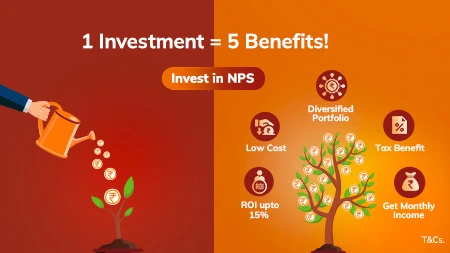THE
ORANGE
HUB
NPS Tier 1 vs Tier 2: Difference in Features, Tax Benefits, Eligibility

When it comes to retirement planning and securing a stable financial future, the National Pension System (NPS) has emerged as a popular choice among individuals in India. To make an informed decision, it is essential to understand the differences between NPS Tier 1 and Tier 2 accounts, along with their respective tax benefits. In this blog, we will delve into the NPS Tier 1 vs Tier 2 debate by going into the details of these two NPS account types. We will shed light on their distinctive features and explore the tax advantages they offer.
What is NPS Tier 1 and Tier 2 Account
Launched in 2004, the NPS is a government-sponsored pension programme to provide individuals with a secure post-retirement income. Initially available only to government employees, NPS was opened to all individuals in 2009. It serves as an annuity product, enabling individuals to build a retirement fund through regular contributions during their working years and later withdraw the accumulated amount upon reaching 60 years.
NPS Tier 1 vs NPS Tier 2: Understanding the Differences:
national pension System offers two distinct account types: Tier 1 and Tier 2. While both accounts contribute to retirement savings, they differ in flexibility, withdrawal options and tax benefits. Let's explore the key differences between the two:
Eligibility and Minimum Investment:
NPS Tier 1: Open to all Indian citizens aged between 18 and 60 years
NPS Tier 2: Only available to individuals with an active Tier 1 account
Minimum investment: Rs 500 for Tier 1 and Rs 1,000 for Tier 2.
Lock-in Period:
NPS Tier 1: Funds in Tier 1 accounts have a lock-in period until the investor turns 60
NPS Tier 2: There is no lock-in period for Tier 2 accounts allowing more flexibility for deposits and withdrawals.
Tax Benefits On NPS Tier 1 And Tier 2 returns :
NPS Tier 1: Contributions made under Section 80C of the Income Tax Act are eligible for annual deductions of up to Rs 1,50,000 lakh. An additional deduction of Rs <50,000> is available under Section 80CCD(1B)
NPS Tier 2: Contributions to Tier 2 accounts do not qualify for tax exemptions.
Withdrawal Options:
NPS Tier 1: Withdrawals are restricted until the account holder turns 60. At that point, up to 60% of the fund's value can be withdrawn, with the remaining funds utilised to purchase an annuity
NPS Tier 2: Withdrawals from Tier 2 accounts are more flexible and can be made at any time, subject to applicable rules and regulations.
NPS Tier 1 and Tier 2: Which Is Better Option?
Both NPS Tier 1 and Tier 2 accounts have their set of advantages and considerations. While Tier 1 offers significant tax benefits and is primarily designed for long-term retirement savings, Tier 2 investments provide more withdrawal flexibility and can cater to immediate financial needs. It is important to carefully evaluate your financial goals, risk tolerance and liquidity requirements before choosing between them.
If you prioritise long-term retirement savings and wish to avail substantial tax benefits, NPS Tier 1 is the ideal choice. With its lock-in period and tax deductions on contributions, Tier 1 ensures disciplined savings and tax efficiency. It suits individuals committed to building a robust retirement corpus and can withstand withdrawal restrictions.
On the other hand, if you require more flexibility and accessibility to your funds, NPS Tier 2 offers greater freedom for withdrawals. It allows you to meet short-term financial goals and tackle unforeseen expenses without any lock-in period. However, it's important to note that Tier 2 contributions do not offer tax benefits, making them less attractive from a tax-saving perspective.
Considering the unique features and benefits of NPS Tier 1 and Tier 2 accounts, some individuals maintain both accounts simultaneously. This strategy allows them to leverage the tax advantages of Tier 1 while having the flexibility of Tier 2 for immediate financial needs. By diversifying their NPS investments across both tiers, investors can balance long-term retirement planning and short-term liquidity requirements.
FAQ’s - NPS Tier 1 vs Tier 2
1. If an NPS Tier 1 investor passes away before the age of 60, what will happen?
In a situation like the sudden demise of the NPS account holder before 60 years old, the legal nominee or heir gets the entire corpus amount and can either continue the account or withdraw the entire amount of corpus.
2. Can I convert my NPS Tier 1 to Tier 2?
No, you cannot convert your NPS Tier 1 account to Tier 2 account. However, you can have both accounts activated to benefit from their respective features. While NPS 1 will give retirement saving plans, the Tier 2 account will provide flexible saving account benefits.
3. Is there any option to appoint nominees for the NPS Tier 1 and Tier 2 Accounts?
Yes, you can appoint a nominee for your Tier 1 and Tier 2 accounts, who will be the legal owner of the account after the original account holder.
4. Is there any investment plan with both Tier 1 and Tier 2 NPS Account?
Yes, you can have investment with both Tier 1 and Tier 2 NPS Account. While investment in Tier 1 can be future planning, post-retirement, investment in Tier 2 accounts can be used as flexible withdrawal under-saving account features.
T&Cs
Scroll to top



